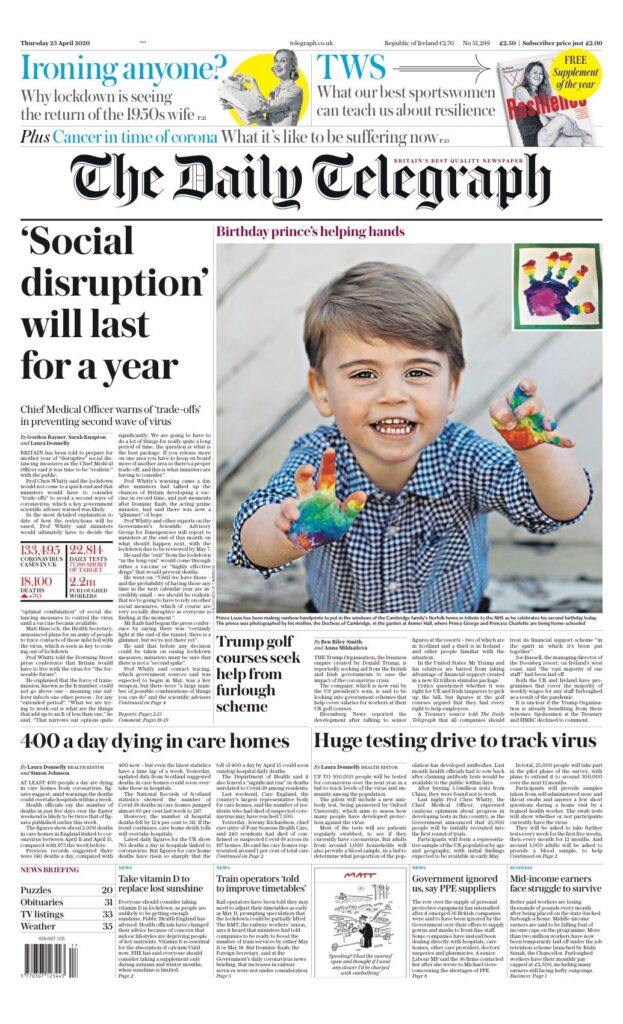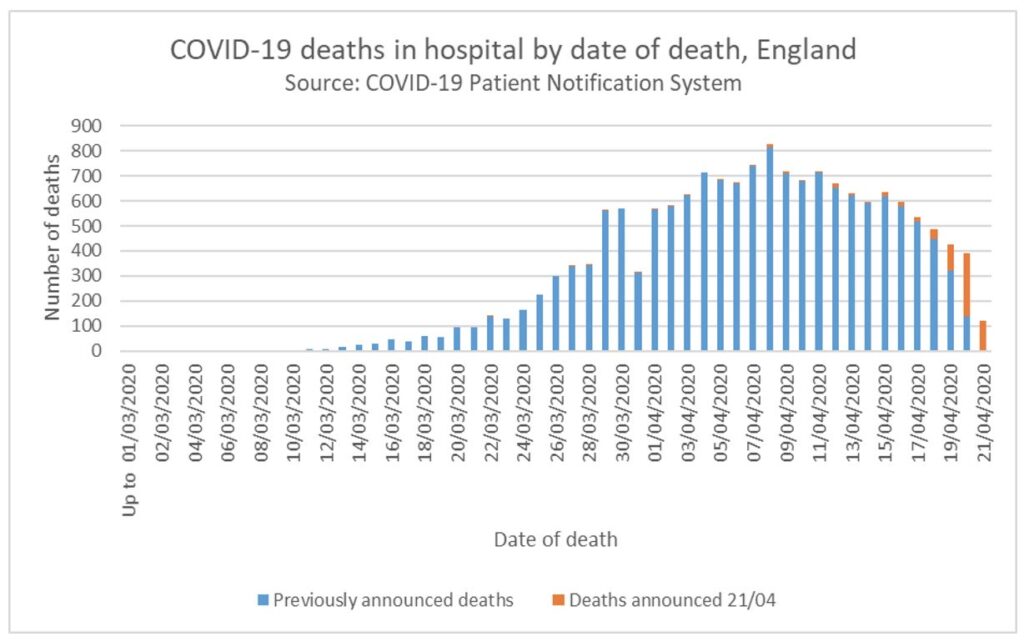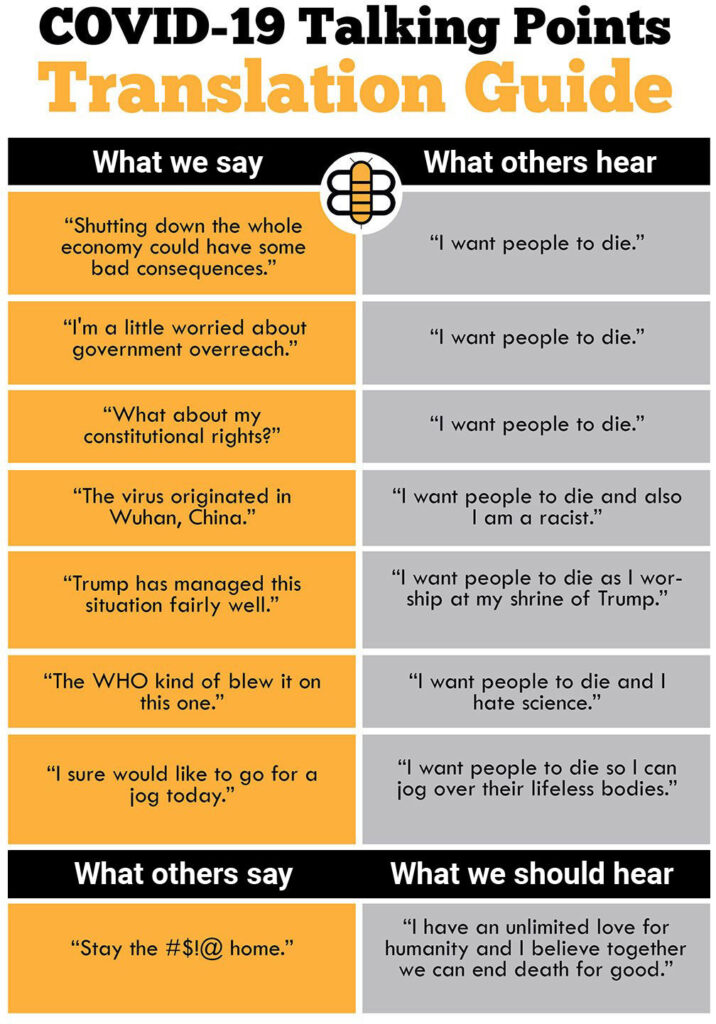
The Telegraph leads on Chris Whitty’s depressing announcement at yesterday the Downing Street press conference that social distancing measures will have to remain in place until a vaccine or “highly effective drugs” are available to avoid a second wave of infections, which could mean well into next year. This bombshell came just moments after Dominic Raab had said there was now a “glimmer of hope”. He didn’t spell out what he was referring to – and he used the same phrase almost two weeks ago, so the glimmer hasn’t got any brighter. But in his speech he referred to “the peak of this virus” three times and implied we’re in the midst of that right now. The Government’s position is that no social distancing restrictions can be lifted until we’re past the peak and there is no risk of a second wave that will necessitate reimposing those restrictions.
I have good news for Mr Raab in that case. There’s growing evidence that the daily death toll peaked on April 8th, as can be seen on the NHS England graph below:

That’s the view of Professor Carl Heneghan, director of the Centre for Evidence-Based Medicine at the University of Oxford. Two days ago he said: “From an epidemiological perspective we can say that the numbers are consistent with the peak happening on April 8th.” As Prof Heneghan has pointed out, if the peak was indeed on April 8th and deaths have begun to decline since, that suggests the more modest social distancing measures the Government introduced on March 16th flattened the infection peak, without the lockdown being necessary. After all, there’s a three-week lag time between infection and death and April 8th is three weeks after March 18th, two days after the mitigation measures were introduced but five days before the lockdown.
More evidence that extreme social distancing measures aren’t necessary to flatten the peak is the analysis done by numerous researchers – including three I flagged up in yesterday’s update – showing that the rate of infections and deaths rise and fall according to the same pattern in every country the virus has struck, regardless of varying population densities, testing rates, case levels, mortality rates, etc. and in spite of the severity of the lockdowns they’ve imposed and when they imposed them in the lifecycle of the outbreak. This is nicely illustrated in the graph below, created by a sceptic on Twitter, which maps the rise and fall of daily deaths in England and Sweden, having adjusted for the fact that Sweden’s are about 10 times lower than England’s. As you can see, the pattern is almost identical, even though Sweden hasn’t imposed a lockdown:

So what are you waiting for, Mr Raab? The doves in the Cabinet will argue that these analyses are all very well but we still don’t know enough about the virus yet to be sufficiently confident that if we start to relax social distancing measures we won’t be overwhelmed by a second peak. But even though that may be true (depending on how you define “sufficiently confident”) it’s not a good argument for delaying announcing a phased exit, as the leaders of Spain, Italy, France, Germany, Denmark, the United States, etc. have already done. No Government can eliminate the risks posed by the virus completely, but keeping lockdowns in place is hardly the risk-free option, given how much economic damage they’re doing. It’s a question of balancing the risks against each other, and in order to do that in a properly informed way our Government needs to listen to sceptical epidemiologists and virologists, not just the most alarmist, as well as economists and business experts. (And educationalists. Only five per cent of Britain’s most vulnerable children are taking up the offer to attend school, according to the BBC, and only 8% of children in the most disadvantaged schools are turning up for online lessons.)
The editor of the Washington Examiner, Hugo Gordon, makes this point eloquently in an op ed published yesterday. Talking about the reluctance of some state governors to end lockdowns, he writes:
It is time to resume commercial activity, at first gradually, and then as quickly as reasonably possible. If we allow ourselves to be frightened into an innumerate expectation of complete safety before life is allowed to return nearer to normal, we will bring on an economic, social, and national catastrophe involving the destruction of America’s wealth, happiness, and place in the world. We must take sensible precautions so the public knows the balance of risk has switched toward activity away from inertia. But a balance still means risk on each side.
Meanwhile, evidence continues to mount that the lockdown itself may be causing more deaths than it’s preventing – and that’s just in terms of its immediate impact on public health, not the long-term consequences of the economic harm. Consultant oncologist Karol Sikora has a piece in the Mail today warning of the catastrophic impact the lockdown is having on non-COVID-19 patients. “Some stroke and heart attack patients are routinely waiting more than two hours for an ambulance, while 2,300 cancer diagnoses are being missed each week because patients are not going to see their GP or because they are not being referred for urgent tests and scans at hospital,” he writes. “Another 400 cancers a week are, it is estimated, being missed because breast, cervical and bowel cancer screening has been suspended. For any of these patients, delay can be a death sentence.” Since the virus struck, the number of patients who are being referred for cancer treatment has dropped by 75%. By Sikora’s estimation, the combined effect of all these delays will be 50,000 excess cancer deaths. (TalkRadio’s Dan Wootton makes a similar argument in today’s Sun.)
The odd thing about the neglect of non-COVID-19 patients is that the hospitals are hardly full of COVID-19 patients. Health Service Journal reports that a new Nightingale hospital in Harrogate isn’t going to be needed after all, so low is the demand, and the flagship Nightingale hospital in London, which has the capacity to treat 4,000 patients, is still largely empty. As if to underline just how underwhelmed the NHS is by the current crisis, doctors and nurses have been posting videos of themselves on YouTube dancing on their wards.
Some people were outraged by the opening paragraph of Monday’s daily update, in which I tried to assess whether NHS workers are more likely to die from COVID-19 by crunching some numbers with the help of Guy de la Bédoyère, a reader who’s well-versed in statistics. On the face of it, NHS workers don’t seem to be dying from the virus in greater numbers than other people of working age. The NHS employs roughly 1.5 million people across the UK, which is about 1/43 of the UK population and about 1/25 of the working population (people aged 20-65). But the number of NHS workers succumbing to the virus is a bit lower than 1/25 of the number of people of working age who’ve died of COVID-19. Of course, if you adjust for the fact that a majority of NHS workers are less likely to be suffering from underlying health conditions than the general working population, it may well be that they are dying in greater numbers. But when Guy and I looked at the data that calculation hadn’t been done. Was that a callous and unfeeling point to make, given that NHS workers are placing themselves in harm’s way every day? The producers of Radio 4’s More or Less don’t think so because yesterday the programme posed exactly the same question and came to a similar conclusion. It calculated that if NHS workers are dying from COVID-19 at the same rate as the rest of the working population, you’d expect between 70 and 85 of them to have died so far. In fact, according to More or Less, 77 have died (or had when they last looked), which is in line with expectations rather than higher. Like us, however, the presenter Tim Harford and his producer added the caveat that NHS workers are likely to be healthier than the average 20-65 year-old, which means you’d expect fewer to be dying if their risk isn’t elevated. You can listen to the item here. It starts at 17m and 23s.
The South African authorities have banned the sale of alcohol and tobacco in the hope of persuading people to remain in their homes, prompting looting to break out in the Western Cape. That’s a particularly brain-dead bit of state over-reach because according to a study carried out in a French hospital nicotine may be both a prophylactic against coronavirus and an effective treatment. It found that of those admitted to hospital with COVID-19, whose median age was 65, only 4.4% were regular smokers, compared with 11% of 65-75 year-olds in the general population. The Guardian has the story.
Bad news for those lockdown sceptic who upload content to YouTube. Susan Wojcicki, YouTube’s CEO, told CNN’s Reliable Sources yesterday that during the pandemic the social media platform will be “removing information that is problematic”, such as advising people to “take Vitamin C” or “anything that would go against World Health Organisation recommendations”. Not sure when YouTube put this policy in place, but if it was at the beginning of the year then presumably any content suggesting COVID-19 was a transmissible disease before the end of January would have been removed because up until that point the WHO was maintaining that there was no “clear evidence of human to human transmission of the novel coronavirus”.
Thanks to all those people who donated to Lockdown Sceptics yesterday – it’s those donations that enable me to devote so much time to this site. If you’d like to donate, you can do so here. I’ll leave you with this table. It was originally produced by the Babylon Bee in a different form, but I’ve adapted it slightly (with help from Ian Rons).














To join in with the discussion please make a donation to The Daily Sceptic.
Profanity and abuse will be removed and may lead to a permanent ban.